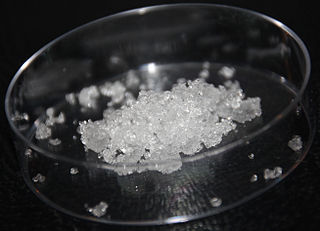Related Research Articles

Europium(III) chloride is an inorganic compound with the formula EuCl3. The anhydrous compound is a yellow solid. Being hygroscopic it rapidly absorbs water to form a white crystalline hexahydrate, EuCl3·6H2O, which is colourless. The compound is used in research.

Ammonium hydrosulfide is the chemical compound with the formula [NH4]SH.

Terbium(III,IV) oxide, occasionally called tetraterbium heptaoxide, has the formula Tb4O7, though some texts refer to it as TbO1.75. There is some debate as to whether it is a discrete compound, or simply one phase in an interstitial oxide system. Tb4O7 is one of the main commercial terbium compounds, and the only such product containing at least some Tb(IV) (terbium in the +4 oxidation state), along with the more stable Tb(III). It is produced by heating the metal oxalate, and it is used in the preparation of other terbium compounds. It is also used in Electronics and Data Storage, Green Energy Technologies, Medical Imaging and Diagnosis, and Chemical Processes. Terbium forms three other major oxides: Tb2O3, TbO2, and Tb6O11.

Ammonium bifluoride is an inorganic compound with the formula [NH4][HF2] or [NH4]F·HF. It is produced from ammonia and hydrogen fluoride. This colourless salt is a glass-etchant and an intermediate in a once-contemplated route to hydrofluoric acid.
Tutton's salts are a family of salts with the formula M2M'(SO4)2(H2O)6 (sulfates) or M2M'(SeO4)2(H2O)6 (selenates). These materials are double salts, which means that they contain two different cations, M+ and M'2+ crystallized in the same regular ionic lattice. The univalent cation can be potassium, rubidium, caesium, ammonium (NH4), deuterated ammonium (ND4) or thallium. Sodium or lithium ions are too small. The divalent cation can be magnesium, vanadium, chromium, manganese, iron, cobalt, nickel, copper, zinc or cadmium. In addition to sulfate and selenate, the divalent anion can be chromate (CrO42−), tetrafluoroberyllate (BeF42−), hydrogenphosphate (HPO42−) or monofluorophosphate (PO3F2−). Tutton's salts crystallize in the monoclinic space group P21/a. The robustness is the result of the complementary hydrogen-bonding between the tetrahedral anions and cations as well their interactions with the metal aquo complex [M(H2O)6]2+.
Isostructural chemical compounds have similar chemical structures. "Isomorphous" when used in the relation to crystal structures is not synonymous: in addition to the same atomic connectivity that characterises isostructural compounds, isomorphous substances crystallise in the same space group and have the same unit cell dimensions. The IUCR definition used by crystallographers is:
Two crystals are said to be isostructural, if they have the same structure, but not necessarily the same cell dimensions nor the same chemical composition, and with a 'comparable' variability in the atomic coordinates to that of the cell dimensions and chemical composition. For instance, calcite CaCO3, sodium nitrate NaNO3 and iron borate FeBO3 are isostructural. One also speaks of isostructural series, or of isostructural polymorphs or isostructural phase transitions. The term isotypic is synonymous with isostructural.
Scandium bromide, or ScBr3, is a trihalide, hygroscopic, water-soluble chemical compound of scandium and bromine.
Nickel is one of the metals that can form Tutton's salts. The singly charged ion can be any of the full range of potassium, rubidium, cesium, ammonium (), or thallium. As a mineral the ammonium nickel salt, (NH4)2Ni(SO4)2 · 6 H2O, can be called nickelboussingaultite. With sodium, the double sulfate is nickelblödite Na2Ni(SO4)2 · 4 H2O from the blödite family. Nickel can be substituted by other divalent metals of similar sized to make mixtures that crystallise in the same form.
Erbium compounds are compounds containing the element erbium (Er). These compounds are usually dominated by erbium in the +3 oxidation state, although the +2, +1 and 0 oxidation states have also been reported.
Protactinium compounds are compounds containing the element protactinium. These compounds usually have protactinium in the +5 oxidation state, although these compounds can also exist in the +2, +3 and +4 oxidation states.
Ammonium hexachlorostannate is an inorganic chemical compound with the chemical formula (NH4)2SnCl6.
Potassium hexabromorhenate is an inorganic chemical compound with the chemical formula K2ReBr6.
Ammonium hexafluoroindate is an inorganic chemical compound with the chemical formula (NH4)3InF6.

Ammonium hexafluoroplatinate is an inorganic chemical compound with the chemical formula (NH4)2PtF6.
Ammonium hexachloroplumbate is an inorganic chemical compound with the chemical formula (NH4)2PbCl6.
Ammonium hexachloropalladate is an inorganic chemical compound with the chemical formula (NH4)2PdCl6.
Ammonium hexachloroselenate(IV) is an inorganic chemical compound with the chemical formula (NH4)2SeCl6.
Ammonium hexachloroosmate(IV) is an inorganic chemical compound with the chemical formula (NH4)2OsCl6.
Ammonium hexabromoplatinate is an inorganic chemical compound with the chemical formula (NH4)2PtBr6.
Ammonium hexabromoselenate(IV) is an inorganic chemical compound with the chemical formula (NH4)2[SeBr6].
References
- ↑ "Ammonium hexabromostannate(IV) ((NH4)2SnBr6) - SpringerMaterials". materials.springer.com. Retrieved 17 October 2024.
- ↑ Emergency Planning and Community RightToKnow Act section 313 reporting guidance for the textile processing industry. DIANE Publishing. p. C-15. ISBN 978-1-4289-0164-3 . Retrieved 17 October 2024.
- ↑ Derz, Friedrich W. (18 May 2020). A-G. Walter de Gruyter GmbH & Co KG. p. 158. ISBN 978-3-11-231592-7 . Retrieved 17 October 2024.
- ↑ Sasane, Akinobu (1970). "Phase transitions in some hexahalostannates(IV) as revealed by the pure quadrupole resonance of halogens". Journal of Magnetic Resonance (1969). 3 (1): 76–83. Bibcode:1970JMagR...3...76S. doi:10.1016/0022-2364(70)90008-9 . Retrieved 17 October 2024.
- ↑ Lalowicz, Z.T. (1995). "Deuteron NMR Spectra of ND4 Tunneling at Low Frequencies in (ND4)2SnBr6". Z. Naturforsch. 50 (50a): 373–380. doi: 10.1515/zna-1995-4-509 . Retrieved 17 October 2024.
- ↑ Ketelaar, A. A.; Rietdijk, A. A.; van Staveren, C. H. (1937). "Die Kristallstruktur von Ammonium-, Kalium-, Rubidium- und Caesiumstannibromid". crystallography.net. Retrieved 17 October 2024.
- ↑ Donnay, Joseph Désiré Hubert (1973). Crystal Data: Inorganic compounds. National Bureau of Standards. p. 301. Retrieved 17 October 2024.